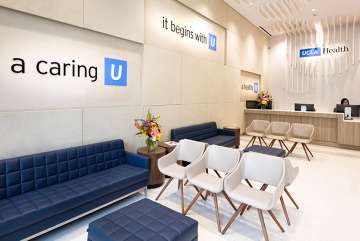Imagery
Imagery should capture the unique personality of UCLA Health, conveying warmth, energy and the feeling that anything is possible. To that end, photos and videos should feel bright and inspirational, with light playing a central role. The sky and the sun represent the brand’s themes as well as the characteristic weather, light and location of campus. Natural light is essential, and plentiful sunshine, natural washouts and sun flares are welcome.
Photography and videography
Lifestyle and patient care

Images of patients and staff should be captured in a photojournalistic style, capturing natural smiles and real interactions. Imagery will vary depending on audience, but in general, patient care images should take on a more warm and engaging style — aspirational, boundless and open to what’s possible. When shooting indoors, the subject should be well lit, and always avoid using a heavy flash. Where possible use natural light with flash fill.

Institutional and procedures
For professional or institutional audiences, photos and videos should feel bold and bright, but take on a more sophisticated style. Staged portraiture should feel refined and graceful, not aggressive or provocative. Sun and natural light should feel present at all times, where possible.
Operating room and procedure photos should also be well lit — aspirational, boundless and open to what’s possible.
Locations and Clinics

The sky and natural light play a key role in location imagery for UCLA Health — it should convey a feeling of possibility and opportunity. When taking photos of hospitals, clinics and other locations, keep as much sky present in the photo as possible. Photos may also be taken from directly below to create dramatic crops of architecture, but this should be used sparingly. Nighttime imagery should be kept to a minimum.
Image library
is designed to support UCLA Health branding by making it easy for our professionals to find and use photos and graphics that help to tell the UCLA story. Our emphasis is on quality images that capture UCLA Health’s distinct personality.
Access to downloading images on this site is limited to the UCLA Health Marketing Department. However, you may browse images.
If you would like to request a specific photo, please select the image you wish to use, and submit the download request form for that image.
Photo and video shoot permits
If you are shooting outside your own department, you need a permit from the Events Office. . See Section B. parts 1 & 2 of .
If you hire an outside photographer or videographer, you need to work with purchasing to ensure the individual has appropriate liability insurance. You should engage the photographer on a work-for-hire basis, or obtain a written agreement that UCLA will have unlimited usage rights to the photography or videography.

Photo / Video permission poster for events
This poster should be visible at UCLA Health events. Download the PDF file and print at 22" x 28" in full color.
Proprietary Rights
All photographs and videos on uclahealth.org representing UCLA Health staff and locations are copyrighted and are the property of UCLA Health.
No permission, either express or implied, is granted for the electronic transmission, modifying, copying, publishing or printing of the photographs or videos contained on uclahealth.org, other than for your personal use.
Express written permission must be granted, on behalf of the copyright holder, UCLA Health, in order to use these photographs or videos for any purpose that is not outlined above. Your use of uclahealth.org or viewing of this statement indicates your acceptance of these conditions.
Photo and imagery specs
Alt text
Image alt text (alternative text) is used within HTML code to describe the appearance and function of an image on a web page. Alt text is a central principle of web accessibility. Visually impaired people using screen readers read alt text to better understand the image, and it also provides context to search engines, helping them to index an image properly. When writing alt text, describe the image as specifically as possible, but keep it short — the most popular screen readers cut off alt text at around 125 characters.
File Sizes and Specs
Print images: CMYK color format, TIFF, PSD, or JPEG at 300 dpi
Web/digital images: RGB Color format, JPEG or PNG ranging from 72 dpi to 300 dpi